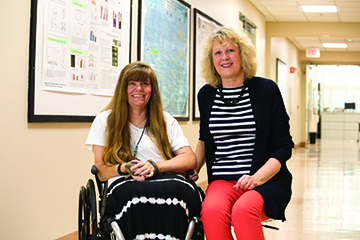Unfortunately, living with chronic spinal cord injury (SCI) can also mean living with chronic pain. Up to 80% of people living with SCI experience some form of long-term pain. The two most common types of pain are muscle-related (musculoskeletal) and neurologic-related (neuropathic), and people can experience either, both, or a mixture of these kinds of pains in multiple areas of the body. Living with chronic pain can have a major impact on life, for example interfering with daily activities, mood, social interactions, and sleep. Effective treatment options are limited, particularly for neuropathic pain, and often come with unwanted side effects. In order to better optimize pain care, it is important to understand the perspective of people living with SCI and chronic pain and identify their priorities and expectations regarding pain management.
Dr. Widerstrom-Noga and colleagues were funded by the Department of Defense to gain this knowledge. First, they interviewed 35 people with SCI living with moderate to severe chronic pain. They identified multiple themes from these interviews and from the most frequently endorsed themes created 42 statements (21 barriers and 21 facilitators) about the experience of living with chronic pain. Second, they surveyed a larger population of people with SCI living with moderate to severe chronic pain (491) to determine how much they agreed or disagreed with the statements.
The results demonstrated that the most common facilitators to dealing with chronic pain were:
- Information regarding pain and treatments
- Resilience
- Coping
- Medication
and the most common barriers to dealing with chronic pain were:
- Poor health care communication
- Pain impact and limitations
- Poor communication about pain
- Difficult nature of pain
- Treatment concerns
People who have the greatest difficulty in dealing with their chronic pain are more likely to experience a combination of: (1) Pain that significantly impacts and limits their daily life activities (2) Pain that has a more difficult nature (e.g., more intense, more constant) (3) Having poor communication with their health care providers regarding their pain (4) Having lower resilience (e.g., lower personal ability to cope) (5) Using more pain medication (6) Being younger. Overall, the findings from this study indicates that most participants view provider-patient communication and educational efforts regarding pain and pain management as priorities and critical needs. It also demonstrates that developing positive coping skills and building resilience are important intervention strategies.
If you are interested in reading this article please contact us at Paininfo@med.miami.edu. Article – Eva Widerström-Noga, Kimberly D. Anderson, Salome´ Perez, Judith P. Hunter, Alberto Martinez-Arizala, James P. Adcock, Maydelis Escalona. (2017). Living with chronic pain after spinal cord injury: A mixed-methods study. Archives of Physical Medicine and Rehabilitation.


